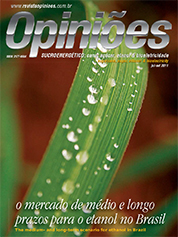Luiz Otávio Koblitz
Board of Directors of Areva Koblitz
Op-AA-29
It’s time for the straw
Sugarcane, more than any other plant, is the most extensively cultivated plant to convert solar energy through photosynthesis. We can divide this stored energy into three roughly equal parts:
1. Sugarcane juice: This one third has always been the objective of the sugarcane culture. Nowadays, one can say that this one third is being well extracted, and depending on the chosen route, with each ton of cane one produces 85 liters of ethanol, or following the sugar route, 105 kilos of sugar, plus 17 additional liters of ethanol – making use of residual syrup.
2. Sugarcane bagasse: When extracting sugarcane juice one obtains a fibrous residue with about 50% of humidity, which we call bagasse. It has always been used as fuel in boilers to produce steam for setting in motion. The thermal balance of such mills in the past was never achieved with the intent of energy-wise optimizing this fuel.
Efficiency was ignored and the main objective was to meet the thermal needs and set the sugar and ethanol mill in motion, in a balanced manner, so that there would be no shortage and no surplus of bagasse.
Thus, the big existing potential for generation of electric power becomes evident, to the extent that one seeks to achieve better energy efficiency. The recovery of the unused part of this second third part is already being implemented in some of the existing 432 sugarcane mills.
3. Straw: This third third part has always been fully discarded, because to facilitate the sugarcane cutting, the leaves, which when dry one calls straw, are burned before the cutting and the top part of the sugarcane plant, which we call top, because it has no saccharose, is cut and discarded in the field. With the gradual prohibition of cane burning, this straw will be used for energy generation.
Considering the potential of bagasse – to this day still mostly wasted – and that of straw, whose use is still in an early stage, the Brazilian sugarcane-based energy industry could be supplying to the “SIN” (National Interconnected System) 12,700 average MW, which amounts to 23.5% of all energy consumed in Brazil today.
The needed installed capacity is 25,100 MW. Considering that with this new technology little more than 2,000 MW already have been or are being installed, we will still need to install 23,000 MW, not to mention the growth of sugarcane plantations, whose projection is to in 10 years increase by additional 420 million tons of sugarcane, i.e., additional 20,000 MW, totaling 43,000 MW by the end of the decade.
At this time, the Decennial Energy Expansion Plan (“PDE” 2020) is being appraised in a public hearing. With respect to biomass, its projections are quite conservative, since they consider only 4,667 MW to be installed until December 2020. These projections correspond to only 20% of the currently existing potential or 11% if one considers the prediction whereby sugarcane plantations will increase.
Another example of such sub-dimensioning can be seen in the forthcoming A-3 / Reserve, scheduled for the month of August, in which 4,580 MW have been announced, distributed in 81 projects, almost the same as anticipated by the “PDE” – 2020 for a ten-year period.
Biomass should be better addressed in auctions from the tariff point of view, respecting tariff rate reasonableness, while however competing separately. To that end, it is necessary that one consider the foregone high direct costs and the indirect benefits this source brings to the National Interconnected System and to Brazilian society like no other.
The main items one may mention are: decrease of investments in LTs e S/Es (transmission lines and substations), because generation goes together with consumption; decrease of wastage in the National Interconnected System; seasonality of generation, occurring in the dry season; equipment, materials, and services sourced in Brazil; increase in the system’s reliability because generation is widespread; it is a tool for planning due to the little time for implementation; it produces low environmental impact and is a clean source of energy.
Brazil is the country with the highest percentage of renewable energy in the world. Considering only electric energy, it is more than 80%, and, when one considers energy overall – fuel for cars, for steam generation in industrial plants and even electric energy itself – it is 46%, compared with a world average of 14%, of which only 7% come from developed countries.
Among the main sources of renewable energy, one may mention: hydraulic, biomass, wind energy and solar. Thanks to the country’s generous hydrographic profile, we have already installed almost 80,000 MW, while still having in excess of 100,000 MW feasible of being installed – although the most part is increasingly farther away from the big consumer centers.
To the surprise of most readers, biomass does not rank second after hydroelectric energy, but first. Of the 46% of renewable energy, 15% come from hydroelectric sources, 14% from sugarcane, 13% from wood and 3% from other sources. Thus, biomass corresponds to 27% of all energy used in Brazil, or about 60% of renewable energy. For Brazil it today is the best source to produce electric energy. We must make it the priority!




